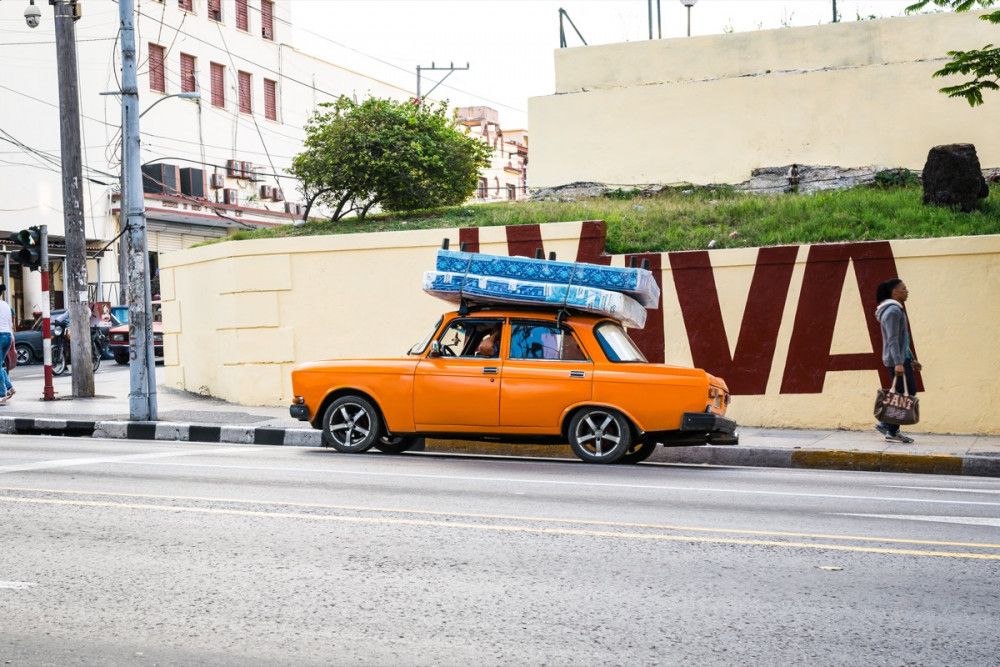Is it Illegal to Tie a Mattress to Your Car? (US & World)

No matter who you are or where you're from, at one point or another you'll have to move a mattress. Now, moving a mattress isn't all that hard. The question that's probably running through your mind is, will I get pulled over for tying a mattress to my car?
Is it illegal to tie a mattress to your car? Tying a mattress to your car is not illegal. It sort of falls in a legal grey area in most states, so there are no laws that explicitly prohibit it. However, tying a mattress improperly onto the roof of your car is 100 percent illegal, because you're endangering not just your life, but also the life of other road users.
Chances of getting pulled over if you do this are very high. That being said, this largely depends on where you're from.
Moving a Mattress Around the World
- In Canada, it is legal, but only if the mattress doesn't cause you to break any laws such as driving with an obstructed view.
- In the United States, particularly in New York, driving with a mattress on the roof of your car is heavily frowned upon. It's not illegal, however, unless doing so makes your vehicle exceed the 8-foot length limit.
- In Australia, it is legal if you don't drive too fast and secure it properly.
- Same applies to the United Kingdom. It can't hurt to give local law enforcement a call to enquire about the legality of it in your region though.
If you only came here to find out whether strapping your 6 by 6 to your Honda Civic would get you in trouble with the law, then you can stop right here.
However, if you feel like you don't know how to securely tie a mattress to your car, or aren't sure what the dangers of driving with a loosely tied mattress on your roof are, then stick around for some nuggets of wisdom.
Driving With A Loosely Tied Mattress is VERY Dangerous
Driving with a mattress on your roof can't be that dangerous, right? Wrong.
It can, and it is very dangerous. In fact, the best case scenario is that you get pulled over and written up. Worst case scenario? You end up in another kind of vehicle with sirens. And, spoiler alert, it's not going to be a cop car.
If you're wondering how exactly your comfortable memory foam mattress can literally kill you on the highway, here's how.
1. It Can Block Your Line of Vision
It goes without saying that driving blind is not the safest way to drive. If you don't align your mattress properly length-wise, it can hang over the front, blocking your view. Hurtling down the highway at 60 mph when you can't see where you're going is certainly asking for trouble. Or at least a significant write up.
2. It Can Turn Your Car Into a Plane
If wind gets underneath the front of mattress while you drive, it can create a small amount of lift. Obviously this doesn't mean your car will immediately take off in a single gravity-defying move, but then again this depends on how big your mattress is, how small your car is, and how fast you're driving, so don't bet on it not happening.
3. It Can Drive Up Fuel Consumption
Lift may not be such a huge concern if you drive slowly and have a big enough car, but the same can't be said about drag. If wind sneaks under the front of the mattress, it can generate a massive amount of drag.
A lot of drag results in reduced speed, which results in you gunning the engine harder, which results in the car burning through fuel pretty quickly. It's not exactly dangerous, but hey, why burn all that gas when you can avoid it by tying down the mattress securely enough?
4. It Can Cause an Accident
If your rope work doesn't hold and the mattress ends up getting blown off your roof and into the car behind you, then what follows may not be very pretty. The thing about driving at speeds of 50 mph + is that even one moment of panic is enough to cause unimaginable chaos.
Remember, when you tie the mattress to the roof, you are exposing it to two types of forces. The wind is one of them, and if it wins, then the drivers behind you won't be so lucky. The second is inertia.
If the rope isn't tight enough, and you brake or corner too hard, then the mattress will probably keep moving in that direction.
None of these scenarios are particularly ideal.
There Are Better Ways to Transport a Mattress
Tying it to the roof of your car should be a last resort, not the first option, because there are a few better ways to get the job done.
Most mattresses can easily fit in a basic cargo van (read the entire article here). Renting a cargo van can be cheap, safe, and easy.
If you know someone that owns a minivan, that can work too. Not all mattress sizes fit a minivan, but most will. If you want to learn more, read my previous article here.
Using a moving truck. This method is safe, available, and best of all, comes with insurance coverage. You might be surprised to find out that your insurance provider doesn't cover mattress-induced car accidents.
Hiring a transport trailer. It is cheaper than the removals truck, and you'll still get to transport the mattress yourself (some people may see this as a downside).
Installing a roof rack. In some states, you might not get away with transporting a mattress without first tying it securely onto a roof rack. If you already have a roof rack on your car, then the job is half done.
If all other options are unavailable, you should at least know how to tie a mattress securely onto the roof of your car. Here is how you might go about that.
Tying a Mattress On Your Roof - A Step-By-Step Guide
First, you'll need to gather a few things:
- Rope
- Scissors
- Mattress bag
- Packing tape
- Work gloves
- An extra set of hands
Step 1: Wrap the mattress
Wrap the mattress completely in the mattress bag, making sure to tape down every loose end to keep it from blowing in the wind. If you don't these loose ends will flap around in the wind. If it's strong enough, it will rip the plastic bag right off the mattress.
Step 2: Haul it onto your car
Once tightly packed in the mattress bag, haul the mattress onto your roof and center it in the middle. Then, place the rope across the mattress length-wise, then secure both ends, starting with the front, then the back, to the front and back bumpers respectively.
Make sure the ends dip down slightly to keep the wind from getting underneath the mattress. Also the rope should be as tight as possible. There should be no slack whatsoever.
Step 3: Tie it up
roll down all the windows save for the driver's window, and weave the rope across the width of the mattress through the open windows. The driver's side should not have any rope sticking out.
The rope should be tight enough to restrict any of the doors from opening, and this is why you need the driver's side to be rope-free. If you have any passengers, they will have to use the driver's side to get in and out of the vehicle.
Step 4: Inspect
Check that there are no loose ends hanging and that the rope is not slacking and is properly knotted at the ends.
There shouldn't be any loose length of rope just dangling by the side of the car either.
Step 5: Moving the mattress
If possible, try to avoid highways, freeways, and busy streets when transporting the mattress.
Instead, stick to back roads as much as possible, and keep an eye on the mattress to see if it's slipping or if any of the ropes come undone. Always be ready to pull over to make adjustments if you notice anything amiss.
A Few Useful Tips
- While tying a mattress straight onto the roof of your car is fine if you do it properly, a roof rack is always better. Paint is slippery, and no matter how tight you tie it, the mattress will shift when you brake suddenly and when cornering.
- Make sure you tie the mattress to at least three or four solid points. More is better in this case. If rope isn't enough, go for canvas webbing (preferably with a ratchet) to get a tighter tie.
- Don't leave any loose ends that can scratch or dent your car when flapping around in the wind. Double-check your work after to ensure the rope is as tight as can be.
- If you're traveling a long distance, top up your tire pressure to handle the extra weight.
Being Smart is Being Safe
Moving a mattress with your car is not exactly illegal, but if you do it wrong there is a 99.9 percent chance that a cop will be flashing lights behind you long before you reach your destination.
Remember, safety should always be the priority. Tie the rope tightly, position the mattress correctly, and keep it from moving as best as you can.
There are always better options for transporting mattresses, so don't automatically go for this one as it is riskier and more cumbersome.
However, if you ever find yourself wondering how to ship your trusty mattress to a new apartment, now you know how to do it legally and safely.
Did you find the answer to your specific question?
👍 12 👎 7
Are you looking for the dimensions of your van?

